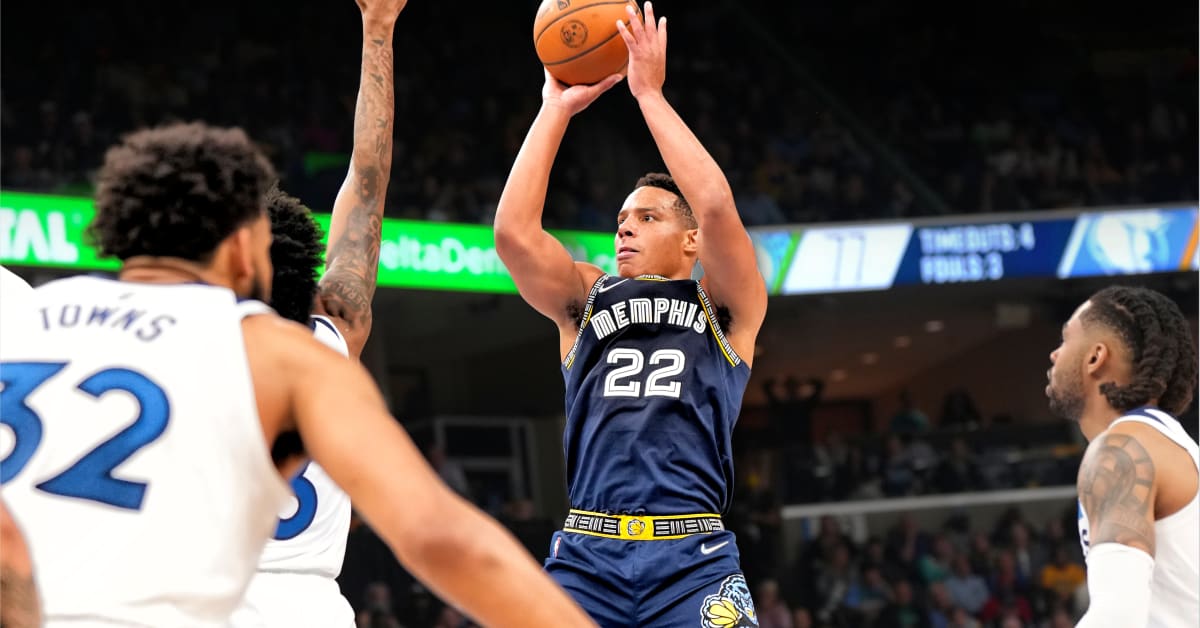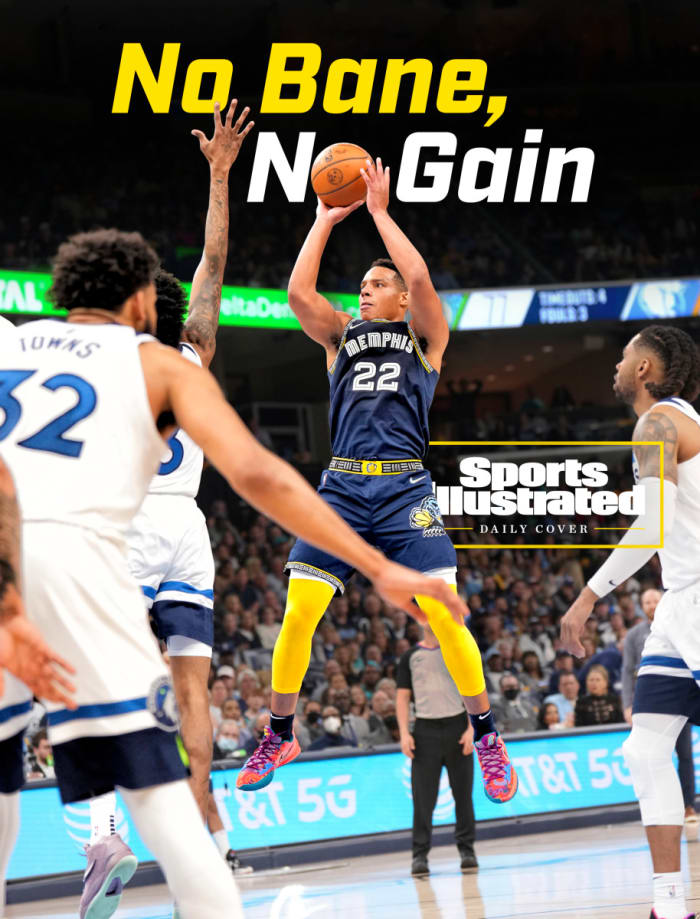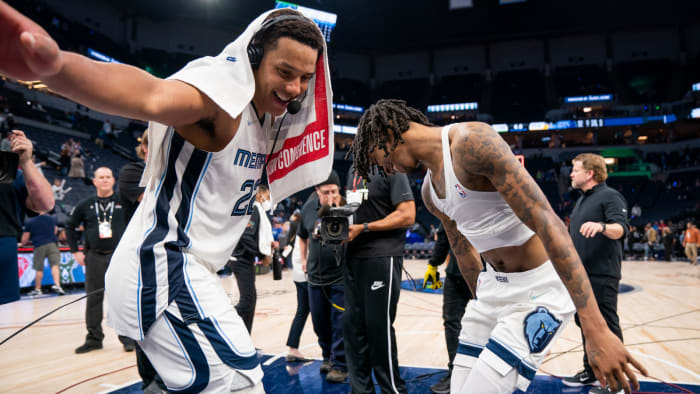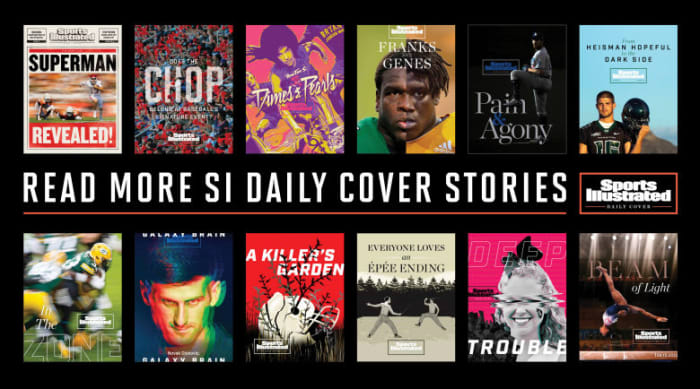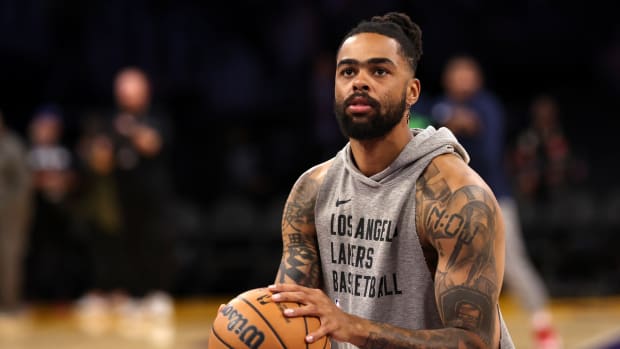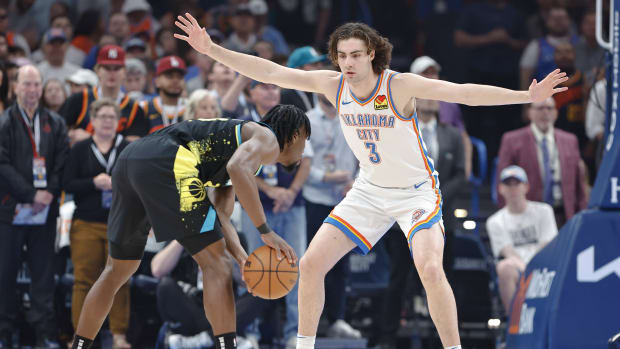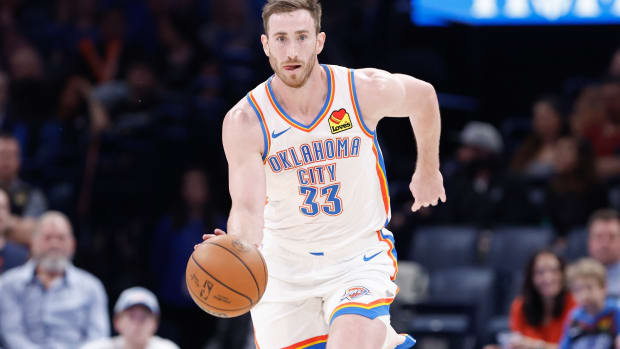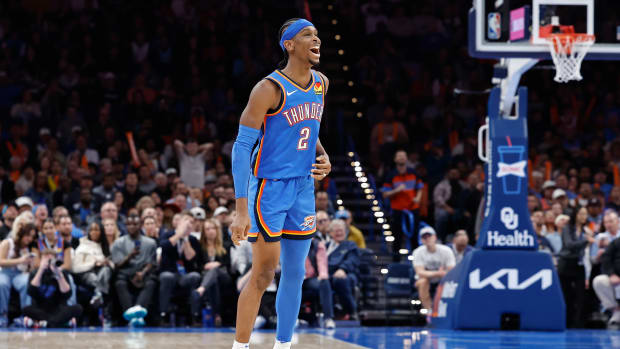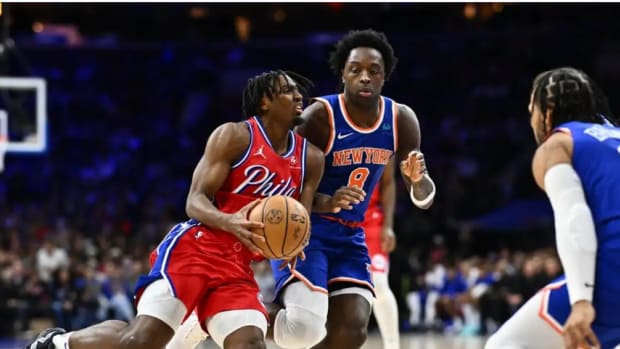Chris Finch should be smiling. Instead, seated on the podium in Target Center’s interview room after his Timberwolves tied up their first-round series against Memphis, the 52-year-old coach wears a long poker face while fidgeting with a black pair of eyeglasses on the table in front of him. Despite its gut-check victory, Minnesota was exposed by Grizzlies guard Desmond Bane, whose three-pointers carried the effortlessness of someone flicking raisins through a hula hoop.
For the second game in a row, Bane exploded behind the arc, going 8-for-12 for a game-high 34 points. (In Game 3 he went 7-for-15.) Responding to a question about the performance, Finch admitted that with Ja Morant also on the court “sometimes you can’t cover it all.” He praised Bane’s off-ball movement and quick release, then acknowledged how his own players somehow underestimated Bane’s ability.
“Sometimes I think his range catches our guys off guard still a little bit,” Finch said. “We kind of short-closed him a few times in the first half, and we talked about that at halftime. We can't do that.”
But over the next two games—both won by Memphis—they did that. Bane scored 48 points, made another eight threes and amplified his growing reputation as one of the league’s premier young talents.
On the whole, these playoffs have placed a spotlight on what Bane has been doing all year, and how important his outside shot is to Memphis’s offense. After finishing second in three-point percentage during the regular season (only Clippers guard Luke Kennard was better than Bane’s 43.6%), Bane is 29-for-64 from deep in the postseason. Those 29 makes are more than any other player. That 45.3% is ridiculous. (A back injury has hampered Bane’s all-around impact in the Western Conference semifinals, which is tied 1-1 heading into Saturday night’s Game 3 at the Chase Center. But Bane’s mere presence on the floor has drawn attention from the Warriors’ defense, so far deploying a strategy that’s opted not to help off him in an effort to slow down Morant.)
There are several ways to illustrate his foundational value on an ascending team that has realistic championship expectations, but few would be relevant if he didn’t happen to be one of the absolute best shooters in the world. It’s the skill that initially put Bane on the NBA’s radar and will be reason No. 1 Memphis may have to offer him a max contract when he becomes extension eligible next summer.
Right now he’s best recognized as an unlikely success story turned compelling Most Improved Player candidate (the actual winner, Morant, literally put the trophy in Bane’s kitchen). As a four-year guard from Texas Christian, Bane basically fell to the very bottom of the 2020 draft’s first round because his arms were too short. He didn’t look the part, or ostensibly possess the same upside that a teenager might.
But in a post–Splash Brothers world, Bane is positioned as well as anyone to plant his flag as the sport’s loudest fire alarm. He’s 23, with a selfless, pass-happy basketball genius as his point guard and, with room to still improve, can already hit so many different kinds of shots at a volume and accuracy few have ever achieved.
When asked how many three-point shooters are better than him right now, Bane has a quick reply. “Steph Curry.”
Anyone else?
“Other than that, you’re gonna have to show me,” he tells Sports Illustrated, leaning back in a courtside seat. “Steph deserves his flowers, and Klay Thompson, I mean, he’s come back from injury. But outside of that I want to be looked at and talked about in the same conversation as those guys. … That’s what I’m striving for.”
Bane grew up playing baseball and football. He came to basketball later than most and says he could naturally shoot from the first time he picked up a ball. But attending a small high school in Indiana didn’t provide top-notch competition. “I was the biggest guy on the court every game I played, so I was just getting to the rim,” he says. “I didn’t really understand how good of a shooter I was until I got to college.”
At TCU, he gradually evolved from a spot-up threat to someone who could let threes fly on the move, with an eventual goal of becoming a useful contributor in the NBA playoffs. To get there, Bane and Ryan Miller—then an assistant coach at TCU (and Mike Miller’s brother)—went on a Danny Green deep dive. They used Synergy to digest every one of the 13-year veteran’s three-point attempts and then absorbed the methods into Bane’s own workouts—how he raced to open spots in transition and used his shot fake to lift closeout defenders off their feet before side-stepping into the clear. (Nobody induces a fly by as well as Bane, who just led the league in one-dribble three-point attempts and made 44.1% of them this season.)
Once Bane folded the type of shots Green did well into his own repertoire, they moved onto Klay Thompson. “In all his made field goals, how is [Thompson] able to be one of the most efficient shooters in the NBA?” Miller asked. After they felt comfortable in Bane’s ability to simulate what makes Thompson so special, they moved on and did the same thing with Devin Booker. (Bane made 43.3% of his college threes and took 208 of them as a senior, which was 48 more than his junior year despite playing 163 fewer minutes.)
“As [Bane’s] levels progressed, we kind of raised the level of player that we could really emulate in our workouts,” Miller says. “As he mastered spot shooting, we transitioned into speed transition shooting and then we transitioned to off-the-bounce shooting. Then we transitioned to shot-fake sidesteps and bump cuts and flare cuts, and we just kept on adding more packages to the game as he mastered each craft at a high level.
“What’s hard for players is they can see it, but [not] incorporate it quickly into their actions. Desmond is always able to. Was it the speed and tempo of a shot-fake sidestep or the speed and tempo you need to go on a cut? Was it slow to fast, fast to slow? He was able to incorporate these in real time … which is really, really unique.”
When NBA general managers called asking about Bane during his senior season, Miller told them at the very worst they’d be drafting Green. And: “As a best-case scenario, you got Klay Thompson,” Miller says. It was a bold claim then. A couple of years later, there’s some evidence to support it.
- There are 156 instances when a player launched more than 500 threes in a season. Bane’s second year was the 10th most accurate. Six of the nine that top it came from Steph Curry or Klay Thompson.
- There are 210 players who’ve ever averaged three or more threes per game in their first two seasons. Bane’s 43.5% shooting ranks fifth. (Bane has taken 794 threes; in the first two seasons of Klay’s career, he also attempted 794 threes and made 40.6% of them.)
- Bane’s 46.1% three-point percentage ranks first out of the 51 players who have taken at least 50 threes in the playoffs during the first two years of their careers.
- There are 392 examples of a player launching at least six threes per game; only 12 have ever been more accurate than Bane was in 2021–22. None were as young.
At a recent shootaround, Grizzlies coach Taylor Jenkins is asked whether Bane is the greatest shooter he’s ever been around or coached. Kyle Korver, who incredibly led the league in three-point percentage for three of the four seasons they worked together on the Hawks, was the only name placed above Bane’s.
“[Kyle] was special in the sense of his routine, his regimen, his mechanics, his mentality, but he also did more than just shooting, and that’s what's pretty impressive about Dez. It’s not just about the shooting, it’s the play making, it’s the defense, it’s the IQ,” Jenkins says. “So I think when it’s all said and done, Dez will have a good argument there.”
All year Bane’s been one of the NBA’s most efficient long range options in a few different ways. Consider: This season, 113 players took at least 200 spot-up threes. Bane’s 44% was fourth best. Meanwhile, 33 players took at least 200 pull-up threes. Bane’s 43.1% ranked first.
Bane’s outside accuracy wasn’t solely thanks to his All-Star point guard’s brilliant shot creation, either. His three-point percentage was actually better when Morant didn’t play (44%) as opposed to when they took the court together (43.3%). Independent of Morant, Bane bends defenses coming off a variety of screens, with a quick release and sense of when and how to relocate along the perimeter. He’s shifty, strong and excellent at moving at different speeds.
His chemistry with Steven Adams, a brick-wall screener, has been unfair at times. And for Bane to have the level of playoff success he’s had in lineups without Adams in the rotation has made his production even more impressive. “If he was here I’d really be getting them up,” Bane laughs.
But that off-the-dribble potency is what places Bane on a special trajectory. As a rookie they accounted for 11.4% of all his shots. This season that number jumped to 20.4%. (If you have 30 seconds, treat yourself by watching this stepback highlight reel.) Just about every area of his game took a step forward, too. When asked to play point guard at Las Vegas Summer League after his rookie year, Bane broadened his skill-set in ways that made him a more dynamic threat than your typical sniper. According to Synergy, Bane went from running 1.4 pick-and-rolls per game as a rookie to 4.4 this season.
“I gotta be respected in a lot of different ways out there on the court,” he says. “And that doesn't pigeonhole me into just being a catch-and-shoot guy or being a movement shooter or anything like that. I can shoot the ball in a variety of ways, score in a variety of ways, do multiple things on the court.”
The next step is finding ways to threaten defenses off a live dribble from distances that really leave defenses vulnerable. “I shoot some out of pick-and-rolls now, but like Dame Lillard and those guys, the volume that they create being able to shoot deep threes and threes out of pick-and-roll, I mean, it changes the game for everybody,” he says. “Now the big has to come up the floor and you’re playing 4-on-3 if you’re not taking the shot.”
If/when that becomes a consistent part of Bane’s attack, pencil the Grizzlies in for a top-five offense so long as he’s on the roster.
In the first round Minnesota’s defensive strategy was to stack bodies in front of Morant, but the series still served as a reminder of who Bane is and an introduction of what’s to come. “[Ja] is obviously the focus and that’s why I feel like we're a good combo,” Bane says. “If they want to sell out on him and pack in the paint then that leaves me open on the perimeter to do my damage.”
In the here and now, Bane is up against a Warriors team that’s intimately familiar with the destructive impact deadeye shooting can have on a playoff series—and along with a back injury, has made a point to curb his production and pose the biggest test of his young career.
Through two games as a main character in Golden State’s scouting report, Bane is 2-for-9 behind the arc. In Game 1, he was doubled coming off pindowns, blitzed in pick-and-rolls and treated with the respect his shot deserves by a rangy, disciplined group that switches everything off the ball and works to deny easy passes. Bane’s man hardly ever shades off him to help on Morant. (Not a coincidence: After averaging 16.8 shots per game in Round 1, Morant has 62 field goal attempts in Round 2’s first two games.)
In Game 2, Bane was hampered by the aforementioned back injury but still managed to log 32 minutes while guarding Thompson and Curry. His gravity mattered, and on one key late possession Bane set a ball screen on Morant’s man to force a switch and drag his new defender (Andrew Wiggins) away from the gap. Morant gorged on the space.
So long as Bane is on the court, Golden State will not ignore him. And, assuming his body allows it, Bane can still respond like the best shooters do, raking in tough looks like they’re dry leaves. If not, the Grizzlies should still be euphoric about everything he’s already done, and the promising future it can allow.
“He has the potential to be one of the greatest shooters in the history of the NBA, to be honest with you,” Miller says. “When he’s open there’s nobody better in the NBA right now. There’s nobody shooting with more confidence than him.”
More SI Daily Covers:
• Deandre Ayton Hasn’t Gotten Over NBA Finals Loss
• Joel Embiid: ‘I Thought I’d Really Lose It’
• Behind Ja Morant’s Sudden Ascent to NBA Superstardom






























